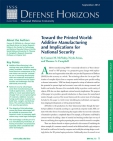Defense Horizons ¹73 September 2012
02 àïðåëÿ 2013
 Key Points
Key Points
• Additive Manufacturing is becoming more cost-effective and widely available. Products ranging from titanium components to human tissue can now be “printed.” Its use is increasing dramatically with new materials and applications, so national security opportunities and challenges must be addressed proactively.
• National security advantages come from manufacturing and medical applications, namely, the ability to create specialized parts cheaply from an ever-growing list of materials. Additive manufacturing could reduce material use, build time, weight, and delivery times. This will bear directly on U.S. security operations.
• The ubiquity of this technology means that these advantages will be available to consumers and America’s rivals. Its consumer applications may create legal challenges.
• This technology could be part of a U.S. manufacturing revolution, allowing innovation and production especially when considered with other technologies.
Âåðíóòüñÿ íàçàä